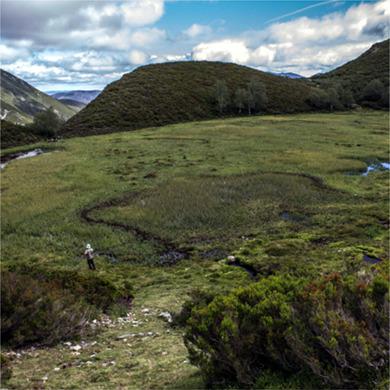当前位置:
X-MOL 学术
›
Int. J. Climatol.
›
论文详情
Our official English website, www.x-mol.net, welcomes your feedback! (Note: you will need to create a separate account there.)
Mire microclimate: Groundwater buffers temperature in waterlogged versus dry soils
International Journal of Climatology ( IF 3.9 ) Pub Date : 2020-10-16 , DOI: 10.1002/joc.6893 Eduardo Fernández‐Pascual 1 , Eva Correia‐Álvarez 1
International Journal of Climatology ( IF 3.9 ) Pub Date : 2020-10-16 , DOI: 10.1002/joc.6893 Eduardo Fernández‐Pascual 1 , Eva Correia‐Álvarez 1
Affiliation

|
Ecosystems adapt differently to global warming through microclimatic factors. Mires are sensitive wetland habitats that strongly rely on local soil properties, making them a good model to understand how local climatic parameters counteract the effects of climate change. We quantified the temperature buffering effect in waterlogged mire soils as compared with adjacent dry soils. We buried dataloggers at 5 cm depth in waterlogged and dry points in eight mires of the Cantabrian Mountains (Spain, southwestern Europe) and recorded soil temperatures for ca. 5 years. We also compared our local measures with air temperatures predicted by the CHELSA model. Waterlogged soils had less diurnal thermal amplitude (−2.3°C), less annual thermal amplitude (−5.1°C), cooler summer maxima (−4.3°C) and warmer winter minima (+0.8°C). CHELSA air temperatures only correlated significantly (p < .05) with winter minimum soil temperatures (Pearson's r > .83), and CHELSA predictions were less accurate (higher root‐mean‐square error [RMSE]) for waterlogged soils, except for the summer maxima. We conclude that mire soils show a thermal buffer effect that insulates them from the surrounding landscape. This effect is stronger at the warm end of the climatic spectrum, that is, during summer and at lower elevations. These results highlight the potential refugial character of mires under global warming, and the need to integrate microclimate measurements into climate change models.
中文翻译:

泥潭小气候:地下水缓冲着涝渍土壤和干燥土壤的温度
生态系统通过微气候因素适应全球变暖的方式有所不同。Mires是高度依赖当地土壤特性的敏感湿地生境,使其成为了解当地气候参数如何抵消气候变化影响的良好模型。与邻近的干土相比,我们对浸水泥土中的温度缓冲作用进行了量化。我们将数据记录器埋藏在坎塔布连山脉(西班牙,欧洲西南部)的八英里的浸水和干旱点的5厘米深度处,并记录了大约1摄氏度的土壤温度。5年。我们还将本地测量结果与CHELSA模型预测的气温进行了比较。涝渍土壤的日热振幅较小(-2.3°C),年热振幅较小(-5.1°C),夏季最高温度较低(-4.3°C),冬季最低温度较高(+ 0.8°C)。p <.05),冬季最低土壤温度(Pearson r > .83),而CHELSA预测除夏季最高值外,对于淹水土壤的预测较不准确(较高的均方根误差[RMSE])。我们得出的结论是,泥泞的土壤表现出热缓冲作用,使它们与周围的景观隔绝。在气候光谱的暖端,即夏季和较低海拔,这种影响更强。这些结果凸显了全球变暖下泥潭的潜在退避特征,以及将小气候测量结果纳入气候变化模型的必要性。
更新日期:2020-10-16
中文翻译:

泥潭小气候:地下水缓冲着涝渍土壤和干燥土壤的温度
生态系统通过微气候因素适应全球变暖的方式有所不同。Mires是高度依赖当地土壤特性的敏感湿地生境,使其成为了解当地气候参数如何抵消气候变化影响的良好模型。与邻近的干土相比,我们对浸水泥土中的温度缓冲作用进行了量化。我们将数据记录器埋藏在坎塔布连山脉(西班牙,欧洲西南部)的八英里的浸水和干旱点的5厘米深度处,并记录了大约1摄氏度的土壤温度。5年。我们还将本地测量结果与CHELSA模型预测的气温进行了比较。涝渍土壤的日热振幅较小(-2.3°C),年热振幅较小(-5.1°C),夏季最高温度较低(-4.3°C),冬季最低温度较高(+ 0.8°C)。p <.05),冬季最低土壤温度(Pearson r > .83),而CHELSA预测除夏季最高值外,对于淹水土壤的预测较不准确(较高的均方根误差[RMSE])。我们得出的结论是,泥泞的土壤表现出热缓冲作用,使它们与周围的景观隔绝。在气候光谱的暖端,即夏季和较低海拔,这种影响更强。这些结果凸显了全球变暖下泥潭的潜在退避特征,以及将小气候测量结果纳入气候变化模型的必要性。


























 京公网安备 11010802027423号
京公网安备 11010802027423号